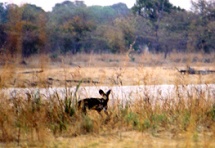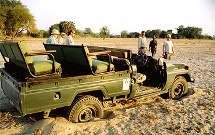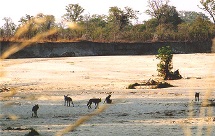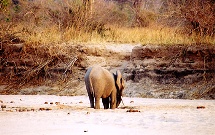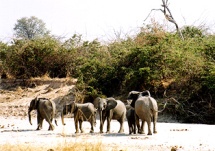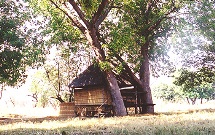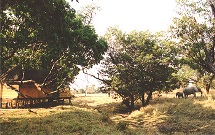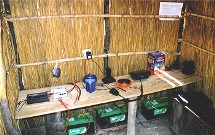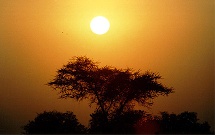Zambia (1): Day Three : Luwi Bush Camp to Nsolo Bush Camp
After a night spent listening to lion roaring what seemed extremely close to camp we prepared to make the transfer to Nsolo Bush Camp on foot through the bush, (our baggage to be brought around for us by vehicle - once the one that we had abandoned had been rescued!).
Then, following a marvellous sunrise, and during breakfast around the camp fire, we spotted a pack of five wild dog trotting across in front of us, just where we had walked back in the dark the previous evening (![]() ). What a treat! The African Wild Dog is one of the world’s most endangered species, with only about 4000 left in the wild. Many people have visited Africa for years, without ever seeing this elegant creature, and we felt very privileged to have had such a high quality sighting (although there was much more still to come!).
). What a treat! The African Wild Dog is one of the world’s most endangered species, with only about 4000 left in the wild. Many people have visited Africa for years, without ever seeing this elegant creature, and we felt very privileged to have had such a high quality sighting (although there was much more still to come!).
In order to gain a better view, everybody rushed off into the bush again on foot (this time accompanied by Isaac), except for the writer, who was once again (although for the very last time) caught lounging in his carpet slippers. However a quick dash back to the hut to change into boots, followed by a solo sprint through the bush, enabled him to rejoin the party.
After completing breakfast we set off on the journey to Nsolo, passing our abandoned vehicle on the way (![]() ). Brian then demonstrated his superb tracking skills by following up the route taken by the wild dog half an hour or so earlier, and we came up with them again, lying up in a dry river bed (
). Brian then demonstrated his superb tracking skills by following up the route taken by the wild dog half an hour or so earlier, and we came up with them again, lying up in a dry river bed (![]() ). Further sightings along the way included elephant digging in the dry river bed for water (
). Further sightings along the way included elephant digging in the dry river bed for water (![]() ), together with the usual impala, zebra and so on, together with more elephant quite close to us (
), together with the usual impala, zebra and so on, together with more elephant quite close to us (![]() ). Along the way we noted some lion droppings containing a porcupine quill – ouch!
). Along the way we noted some lion droppings containing a porcupine quill – ouch!
We arrived at Nsolo after a four hour walk to be greeted by our hostess, Kate, and the first Mosi of the day (10.00 a.m. – well, we needed it). Nsolo consists of a small number of huts mounted on low stilts (![]() ), situated a few hundred yards in front of a water hole shaded by a number of trees, which proved to be a very popular drinking spot for numerous species. It was delightful to just sit in the camp’s boma during the afternoon, the accompanying photograph (
), situated a few hundred yards in front of a water hole shaded by a number of trees, which proved to be a very popular drinking spot for numerous species. It was delightful to just sit in the camp’s boma during the afternoon, the accompanying photograph (![]() ) demonstrating how some of the best game viewing is actually achieved by simply sitting in your own hut, waiting for the game to come to you, rather than driving out to seek it.
) demonstrating how some of the best game viewing is actually achieved by simply sitting in your own hut, waiting for the game to come to you, rather than driving out to seek it.
Before setting out on the afternoon game walk, after a pasta lunch, we took a look at the kitchen area and communications room (![]() ), and examined the bush ‘technology’ of the camp’s cool store – a small hut with solar panels on top, and chicken-wire enclosed charcoal panels, which were water cooled.
), and examined the bush ‘technology’ of the camp’s cool store – a small hut with solar panels on top, and chicken-wire enclosed charcoal panels, which were water cooled.
During the game walk itself, with our new guide, Shaddy, and Park scout, John, we saw warthog, more elephant digging for water, impala, and bushbuck, and walked up quite close to buffalo (the Park scout finally unshouldering his gun). Following an awesome sunset (![]() ) and sundowners, a short evening game drive then yielded our first sighting of the huge and stately eland. On return to camp, fresh lion tracks were noted just a few metres away, those responsible probably lying up unseen in the bush observing our progress.
) and sundowners, a short evening game drive then yielded our first sighting of the huge and stately eland. On return to camp, fresh lion tracks were noted just a few metres away, those responsible probably lying up unseen in the bush observing our progress.
On our return a wonderful barbeque awaited us, with the best beef we’d ever tasted, and was eagerly consumed with the help of a few more Mosis, although some of us were then kept awake for part of the night by buffalo rooting around near and underneath the huts.

Scientists can never stop being scientists, and on one trip a couple of this species entertained themselves one evening by carrying out a few relevant calculations, based on a few simple, but reasonable assumptions (as scientists do).
These started with an estimate of the number of tsetse fly bites required to completely drain the human body of all of its blood (around 40,000).
They then progressed to an estimate of the frequency of elephant relieving themselves (based on observation of their eating and digestive habits, and the size of a typical pile of droppings), coming up with the figure of once every 45 minutes, which the guide said was remarkably accurate.
These calculations were being carried out in an extremely ‘bushy’ camp, featuring that delight of outdoor living – the long drop loo. Being told that a new such pit was dug each time the camp was set up (although privately we have our doubts), they then calculated the probability of hitting a previous pit – quite high. Enough!
| Back to previous page (Day 2) | Forward to next page (Day 4) |
